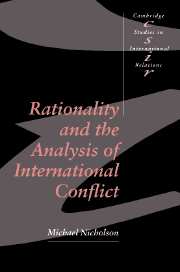Introduction: Rationality and the analysis of conflict
Published online by Cambridge University Press: 24 November 2009
Summary
A traveller on the back roads through northern France near its borders with Belgium is struck by the number of cemeteries. These do not contain the mortal remains of the elderly and unfortunate of the region, but those of many young men from all over the world who had little reason to want to go there in the first place. However, between 1914 and 1918 many did go, to live for a while in misery, discomfort and terror, and a tragically large number died there. Small and unimportant towns like Passchendaele, Verdun and Mons, small rivers like the Somme, are now symbols of the wastage of young men's lives by societies which, by many other criteria, were highly civilised. The whole area seems a colossal monument to doomed youth, and indeed was seen as such by many of the generation who went there and survived it. Poets and writers such as Siegfried Sassoon, Robert Graves and Wilfred Owen have made the experience vivid for later generations. It may be the literacy of the participants as well as the sheer scale and horror of the events which has made the First World War so particularly vivid for so many people who have no direct memories of it. If this were one isolated event in history, we would look at it with horror. Unfortunately it is not.
- Type
- Chapter
- Information
- Publisher: Cambridge University PressPrint publication year: 1992



